You’ve decided on the perfect pepper grinder and it has arrived on your doorstep. But you certainly don’t want to fill your shiny new toy with old, stale peppercorns!
When you have a high quality mill, you want to take full advantage of its ability to provide you with incredible flavor.
Whether you are interested in black, white, or colored varieties, getting the most out of your grinder means stocking your kitchen with the best specimens of this particular spice.
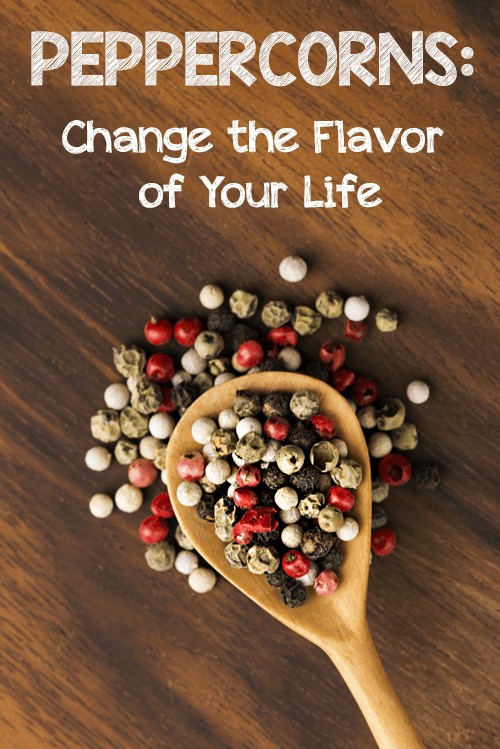
But can choosing the right products and varieties really make a difference in your cooking?
It definitely can!
With the huge variety of spices available on the market today, it can be difficult to decide which ones to buy. This little guide should help you along in understanding what’s what in the world of pepper.
Peppercorns: What’s What
Peppercorns typically come from the common tropical plant, Piper nigirum. This is a woody, flowering vine that has been used since ancient times and originated from India, which has been known to grow up to 30 feet in the hottest climates.
In ancient times the dried fruit was considered so precious that it was often used as currency for trading.
Piper nigirum is now grown in various parts of the world that have tropical climates, with the highest production and export coming from Vietnam.
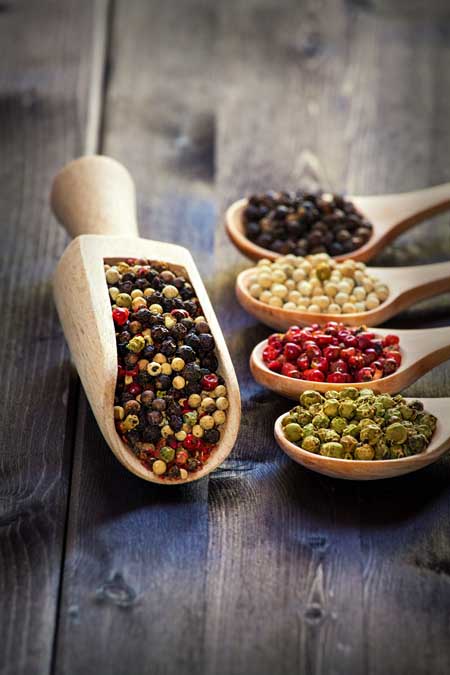
Just like coffee beans and grapes, the climate and soil of the place where the vines are grown will greatly affect the flavor, as will the ripeness and processing of the fruit.
The berry-like fruit of Piper nigirum starts out as a small, white flower that turns into a bright red berry when allowed to ripen completely.
The fruit may be picked when it is partially ripe or fully ripe, which accounts for the differences in color of the final product.
The oils in the berries that affect the flavor the most are terpenes and pyrazines, which create hints of clove and citrus flavors as well as earthy aromas.
More Pepper=Less You
We don’t often consider the nutritional and health benefits of spices, maybe because they seem like such a small part of our diets. However, many spices have health benefits to offer, including pepper’s ability to work as an antioxidant, antibacterial, and even as a thermogenic warming spice.
The piperine compounds found in the spice may be able to boost metabolism, meaning they can help you to burn calories and maximize weight loss. It’s also source of copper, manganese, vitamin K, iron, chromium, calcium, and dietary fiber.
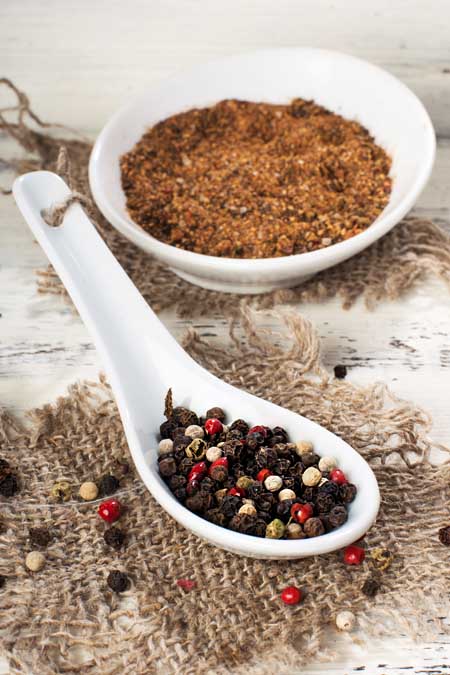
This spice is also known to stimulate the appetite as well as aiding with digestion by sending a message to the stomach to increase the secretion of hydrochloric acid. The acid helps the body to digest the food rapidly and avoid the production of uncomfortable intestinal gas.
So get your grinder ready and choose your peppercorns to fill it with, because the health benefits are numerous.
Green (and White and Pink and Red) Is the New Black
Name the first color that comes to mind when you think of pepper.
Black, right?
Sure, the ubiquitous pre-ground black variety is a staple but you’ve got to get more creative when you think of peppercorns. Imagine all of the colors of the rainbow and then you’ll be on track.
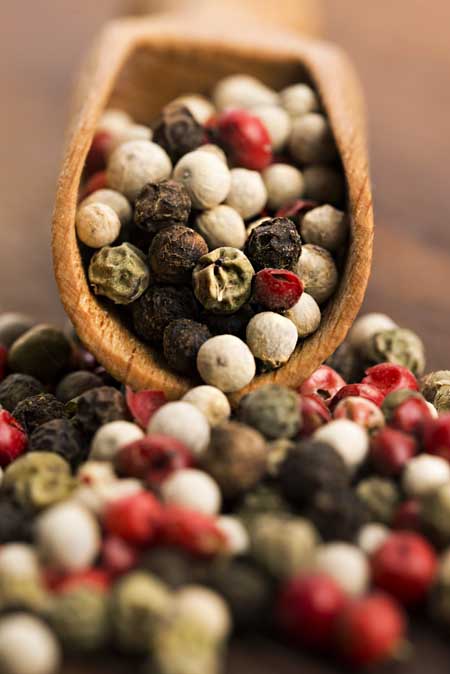
Here’s the rundown of why you want to add more color to your life (and your table) in the form of pepper:
Black and White Peppercorns come from berries of the plant that are picked when they are mostly (or completely) ripe.
The greatest difference between black and white versions is that the outer shell has been removed from the white leaving only the seed, while the black variety still has the outer shell on it.
That black outer layer is what most people are expecting when they use the spice, and removing it makes a difference in the taste as well as the look of the food that you add it to.
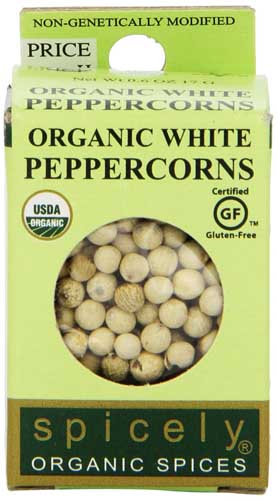
Check out the Spicely Organic White Peppercorns available on Amazon
Typically the white version is used simply for visual appeal rather than specifically for the flavor, but it does have an earthier, less pungent flavor than the black version.
The green type is simply the unripe version of the same plant that produces the black and white varieties. Because they are unripe, the green ones are a bit more difficult to preserve and they don’t usually last as long in dried form.

This means that it may be best to buy them in smaller quantities more often, rather than buying in bulk and expecting them to keep. And that works out well because the inconvenience of processing green peppercorns means this type is one of the more expensive of the bunch.
Green versions of the spice have a less potent flavor and are widely used in French, Thai, and Creole cooking.
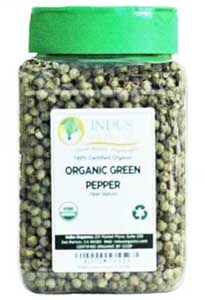
Foodal recommends Indus Organics Malabar Premium Grade Dehydrated Green Peppercorns
Red varieties come from the same plant as the black, white, and green types, but they are a little less common. Note: This is not to be confused with “red pepper,” which may refer to ground capsicum or cayenne.
When the fruit stays on the vine and comes to full maturity, it is bright red.
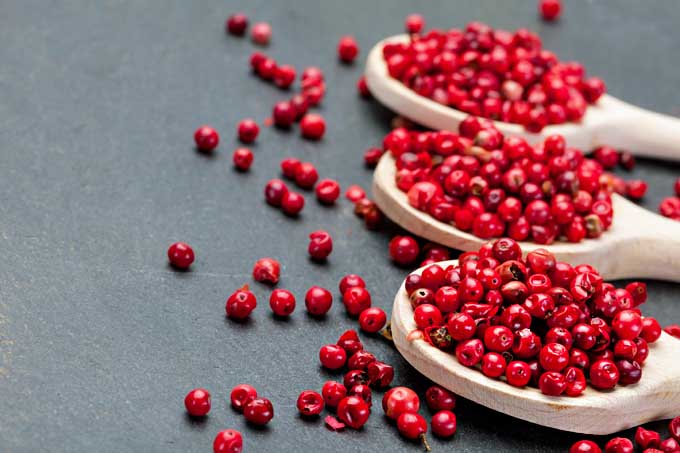
Then, as the red berries dry, they tend to darken and often simply turn into the black version that most people are accustomed to.
When Pepper By Any Other Name Isn’t Pepper (But Taste Just as Good)
Partying it Up With Pinks
Pink versions of this whole spice (sometimes called Rose) are actually a misnomer in that they come from a completely different plant, Schinus molle or Shinus terebinthifolius, sometimes known as the Peruvian peppertree or South American pepper.
Indus Organic Whole Pink Peppercorns (Shinus terebinthifolius) available on Amazon
Preparing this pink variety for use as an ingredient is much easier in a mortar and pestle rather than using a traditional mill since they are much less dense than true black and white berries.
Note: Be sure to avoid Schinus molle/terebinthifolius derived products if you have nut allergies; they are related to cashew and other nut bearing trees.
Another similar plant is Baies roses, a perennial flowering vine located on the French island of Reunio (Pimienta Rosada) n in the Indian Ocean.
Because these dried pink berries look a lot like traditional peppercorns, they are often still referred to as a pink version of pepper.
Badia Pink Whole Pepper Berries (Pimienta Rosada) available on Amazon
The flavor may be slightly mild with a hint of sweetness and acidity.
This pink spice may be a bit more expensive than what you might expect from the white or black versions, and may be more difficult to find because it is more unique and not as popular.
These add a touch of sweetness but are most often used in blends for their color, rather than for their flavor.
Get Exotic With Szechuan
Szechuan pepper (aka Sichuan aka hua jiao) is another psuedo peppercorn.
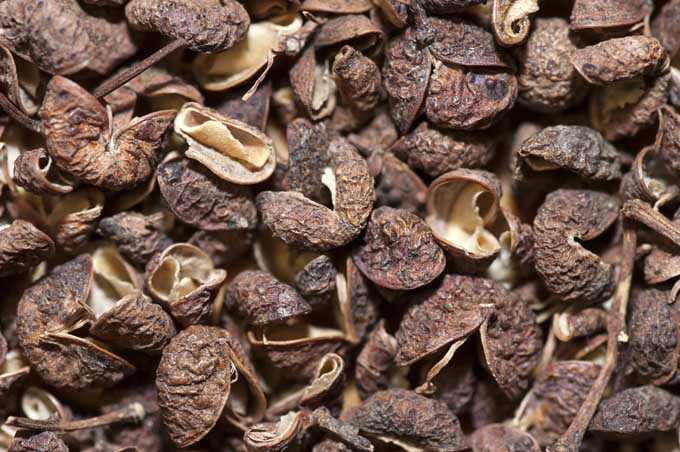
Szechuan is a highly fragrant spice derived from the husks surrounding the seeds of the Prickly Ash Bush. This spice was used in various dishes within China will before the common peppercorn spread outward from its native regions.
Szechuan Pepper Tin available on Amazon.
Depending on the amount that is is added to dish, the effects range from a tingly to a numbing sensation and when used in very small quantities, and can add a whole lot to the taste that can’t be recreated with any other spice.
Again, you’ll need a mortar and pestle or an electric coffee grinder or spice grinder to prepare these.
Check out this Kung Pao Chicken recipe for ways to use this very fragrant and powerful spice.
Are All Peppercorns Created Equal?
Consider the fact that these little gems come from a variety of different places, are grown in distinct soils, and are processed in a variety of ways.
If you begin paying more attention to the aroma and taste, you’ll realize that there are a plethora of unique selections and a vast range of flavors. Here’s a small grouping of some of the most interesting options:
Tellicherry
Called Tellicherry after a town on India’s Malabar Coast, this version of the spice is considered gourmet and is often preferred among chefs and others with high culinary standards.
The berry actually comes from the same Piper nigirum plant, but it is allowed to ripen for a longer amount of time before it is picked. This means the flavor is given time to fully develop into something that is more intriguing and complex.

Foodal recommends Indus Organics Freshly Packed Tellicherry Black Peppercorns
Rather than just being hot and sharp like other peppercorns, the Tellicherry version is slightly more fruity and citrusy, with a bright freshness. It offers a more balanced, almost grassy flavor and aroma, and is considered one of the most sought after examples of the spice.
Lampong
From Indonesia, this spicy version offers a slow burn that develops as time passes. With woodsy and citrusy aromatic notes, the scent seems to be more powerful than the actual flavor.
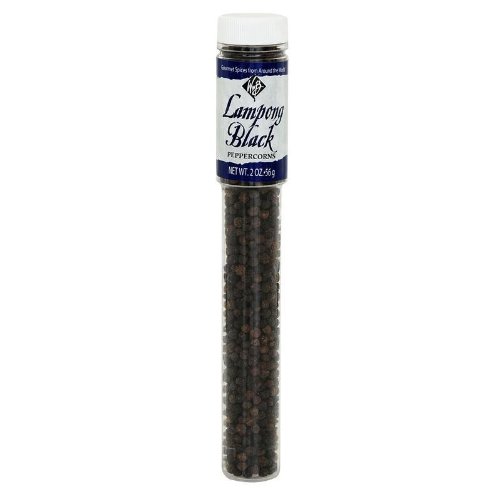
William Bounds Lampong Black Peppercorns available on Amazon
Great for use when freshly cracked at the table, over a salad or steak, sharing the aroma with the end user.
Muntok
Traditionally used in blends, these berries are grown and harvested in Indonesia where they are soaked in cool water barrels to loosen the outer shell.

Spice Appeal Muntok Whole White Peppercorns, 22 Ounce
These are often very hot and provide a taste of mild fermentation similar to other white options, but with a strong kick.
Brazilian
Extremely strong and pungent, this version offers an intense brashness that quickly turns into a kinder undertone. This one is effective when used alone for abrupt flavor, or works well when added to a blend of others that last longer.
Vietnamese
The largest supplier and trader of the spice in this day and age, Vietnam offers a rather “standard” version of peppercorns and are often the common variety that you’ll find at Trader Joe’s or your local warehouse club.
Useful for every day, the aroma is powerful but the taste has a bit of mellowness. Simple and pleasant, this type might go well blended with other, more zesty varieties.
Sarawak
From Malaysia, Sarawak offers an earthy tone with a moderate flavor. This one acts as a changeling, depending on what you use it with. Slightly sweet and spicy, this is a good basic variety for using on the table or in sauces.
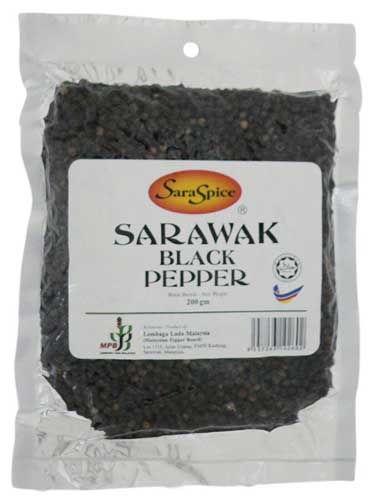
Sara Spice Sarawak Black Peppercorns, imported direct from Malaysia and available on Amazon
These may come in a creamy, white form that has been picked at the beginning of ripeness and then placed in a cool stream for a couple of weeks to remove the outer shell, leaving only the seed.
Talamanca
Zipping over to Ecuador, we find this unique chili-like option that provides a slow heat and sharp flavor. Slightly bitter, the verdict is still out on whether it is loved or hated, which obviously means that the affections one may feel lie within the realm of personal preference.
Become a Pepper Aficionado
Because there can be such variety even within the same regions and areas of the world, it is really best to perform your own tasting to see what you like best. If you head over to a store that has a large selection and will sell in small quantities, you can pick up a few versions to see what you like best.
As with most spices, the expected flavor may often be indicated ahead of time by its aroma.
Although the full flavor is not released until the shell is cracked open, it is still possible to get some idea of what you can look forward to simply by smell.
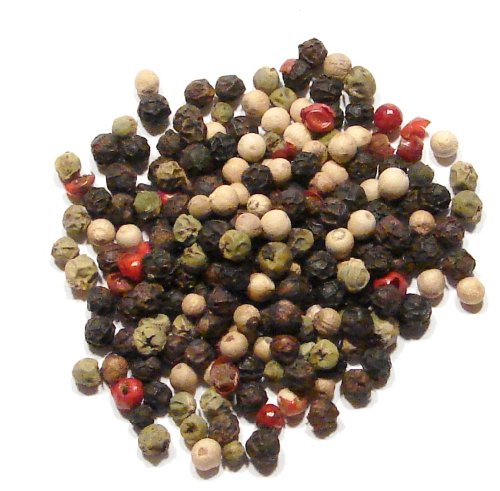
Can’t make up your mind? Foodal recommends Denver Spice’s Rainbow Four Color Peppercorn Blend
Not to mention the fact that you can begin creating your own blends and turn this into a custom venture.
There’s a whole world of expanded flavor out there just waiting to be explored!
About Julie Workman
As a freelance writer for over 15 years, Julie Workman has been published in various magazines, books, and online media. She holds a college degree in Home Economics which she uses every day in overseeing her household and making her home a happy place for her family.

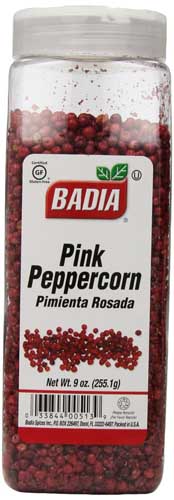
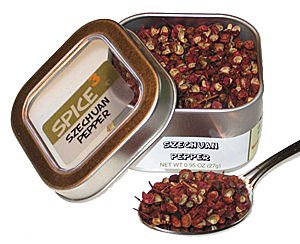
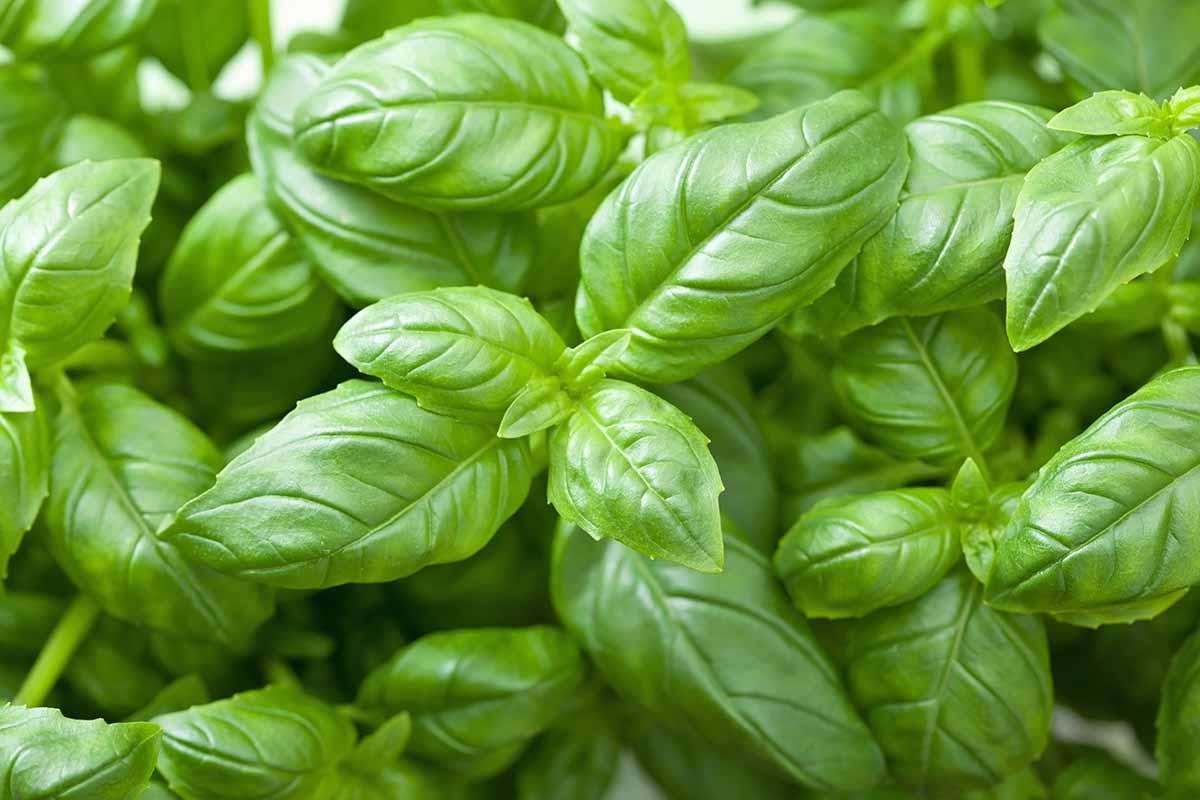
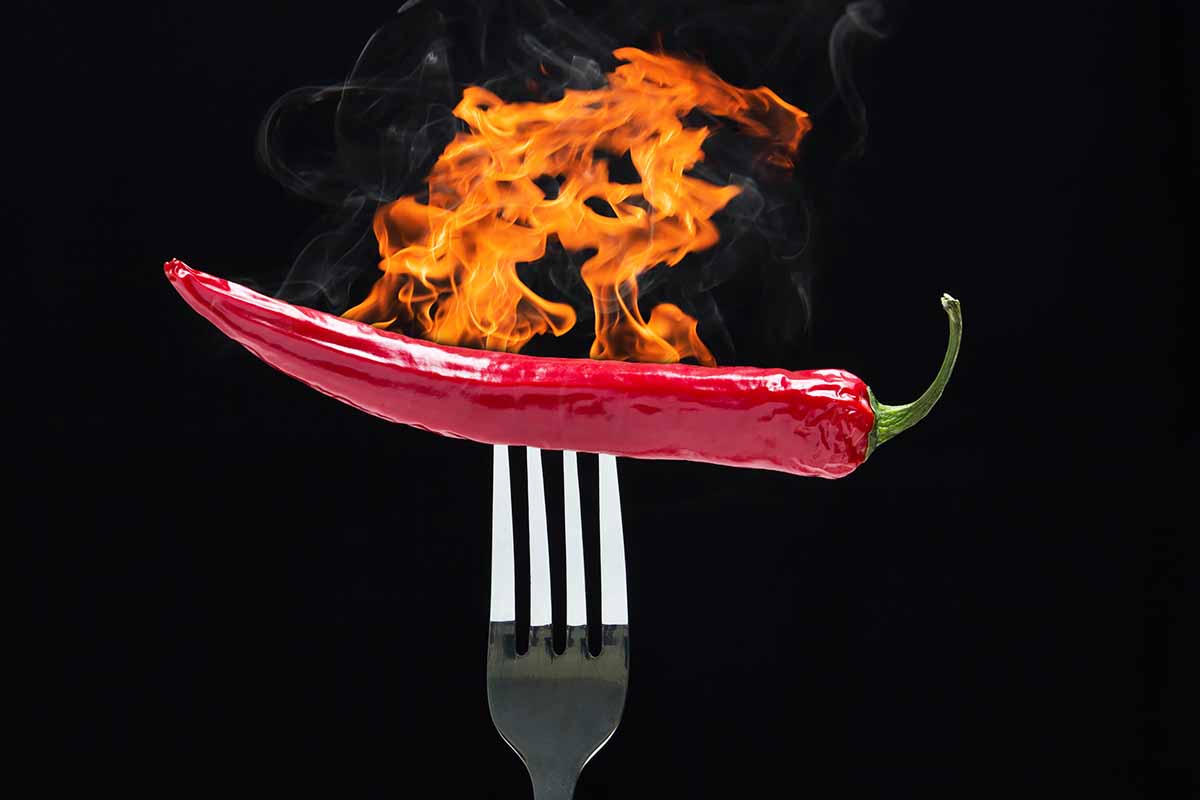
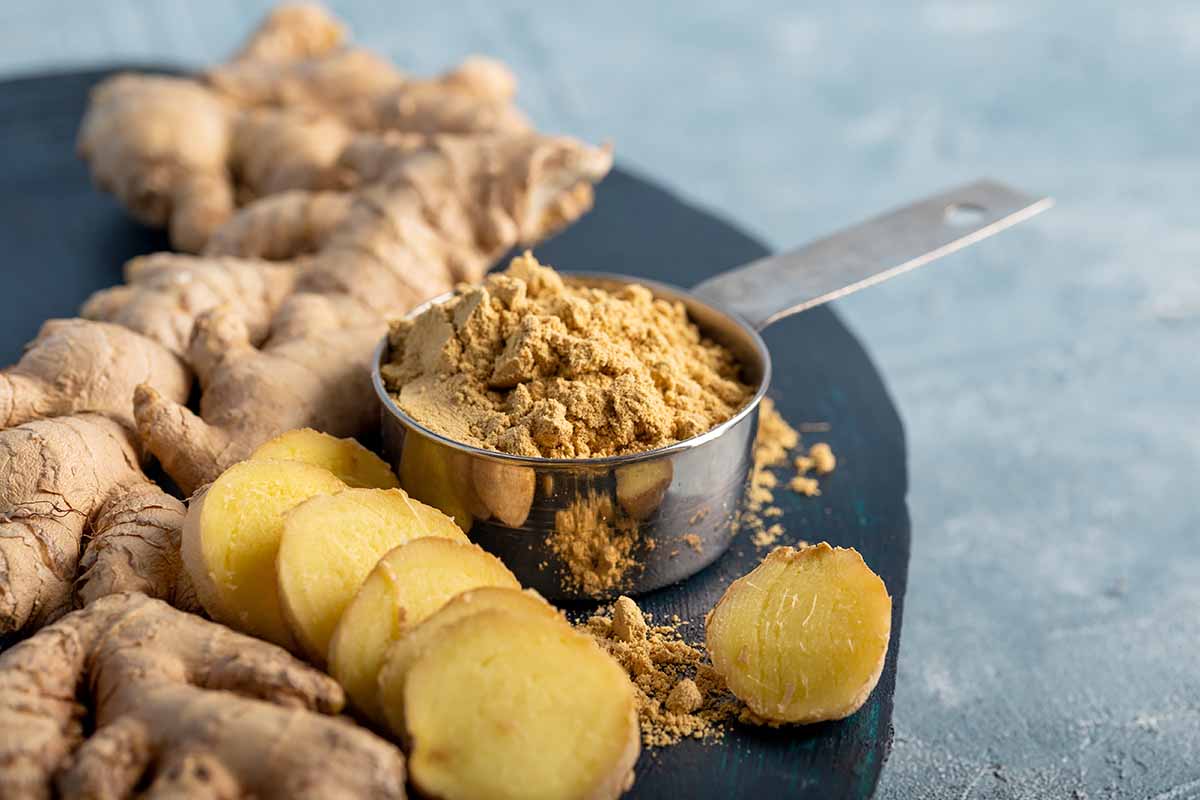
They say that variety is the spice of life. The colors being shown in the photos look amazing.I’m so used to the conventional black peppercorn and I never even considered any other type. Thanks for the info on the health benefits of eating this spice. Now I have a bit more incentive to try to add peppercorn into my diet.
This is one aspect of my cooking skills that is definitely lacking. I really don’t have a good grasp on spices, and articles like this one, that provide in depth information, provide me with a good foundation. I am looking forward to exploring the different varieties of peppercorns, especially the pink types, even if they’re not truly peppercorns!
I never used to like the taste of pepper in my food but I believe that was more to do with using the stale ground stuff in from a can. Previously I would always just put in plain old black no matter what the dish. After a little bit of experimentation freshly ground has definitely grown on me. Thanks for the inspiration! I’m especially keen to try out some Vietnamese recipes.
This is such an interesting article…I’ve always really enjoyed using pink peppercorns but I had no idea that it’s not even technically a type of pepper! I worked at a bulk foods store several years ago and it wasn’t until then that I discovered how many variations there are on this basic spice. I don’t have a grinder currently so I’ve only been using regular pre- ground, but this article definitely gives me a great jumping off point to try some new colors and flavors. The Muntok variety sounds especially interesting, I like spices that can give my dishes a bit of a kick!
Peppercorns? Huh, that’s something that I haven’t heard about until now. It might be due to the fact that I’m a total newbie when it comes to spices but I keep learning everyday. This article contains a lot of good information, even for the more expert ones.
Personally my favourite pepper to use are the black and reds. I love mixing them together while cooking, it’s amazing what they can do to a dish. I just moved places and I’m without a pepper mill and mortar and pestle and I’m dying because I haven’t been able to make use of my peppers, other than using them whole (which my family aren’t fond of!!
I do enjoy pepper corn the texture is so different. I’m all about trying new things I haven’t really used them in my own kitchen for cooking. When I go out to eat is when I like to enjoy chomping down on these little treats.
This is a wonderful article about the plethora of pepper choices out there! I love pepper but I’ve only ever tried black and pink peppercorns. Now, I am looking forward to trying even more varieties of pepper! Especially when I try out new restaurants and cuisines.
Also, I cook a lot for my family and I certainly need to invest in a good pepper mill if I want my family to appreciate the seasonings.
I love pepper! I mostly use black, because I’ve read that black pepper is necessary to bring out the health benefits of tumeric powder, and we have a lot of that in our traditional dishes. I also bought some pink pepper berries (dried, of course), but was unsure how to use them. Now that I read they’re more for deco, I might be even more hesitant! We don’t have visit often enough for me to break out any fancy decoration tricks… Oh well. Very nice informative article, I’ll try to seek more variation from now on!
I had no idea these had so many nutrients. I am also surprised about how they help digestion. Somewhere in my life, I was led to believe pepper aggravates the stomach. All the different types are interesting and all the flavors seem intriguing. Tellicherry sounds like the one I would like to try.
Awesome article to read at the perfect time for me! I just recently looked into different types of pepper and salt. I’ve been really liking ground white pepper. I’ve really liked pink peppercorns (or that other long name it’s actually called!) but I never bought any or cooked with it. I love trying and learning about different spices – thanks for this information!
I never knew there were so many different kinds of peppercorn! I’m just learning how to cook, and I don’t really use black ground pepper when I cook, but I’m eager to try these different colors. Thanks for going so in depth on their different histories and flavors. I kind of want to try the pink peppercorn just for their color. I hope I like how it tastes because I have every intention of making everything I make adorably pink. Thanks for the article!
This was really interesting! I’ve been adding white pepper to my cooking for a long time. I really like the slightly more subtle flavor. I’ve also had fresh green peppercorn in Thai curries. I’ll have to check the nearby Asian grocery store to see if they carry them. Thanks for sharing!
Wow, I have only just recently gotten into freshly ground pepper . I have always been into coffee beans and the subtle variations found there, and since I’ve begun cooking, grinding my own peppercorns has become a new addition. I, as the article mentioned, am the proud owner of a new grinder. I truly didn’t realize there were so many variations and colors to choose from. I’m still a bit new to grinding my own, but I can say this with a certainty, nothing adds as much flavor to a dish or as much color (as I just learned) than freshly ground spices. Great article here and extremely educational as well as entertaining.
Haha, I realized while reading this that I had absolutely no clue what peppercorns were (a fruit, really?) I feel ignorant. Thank you for the informative post, as I am a huge fan of the flavor pepper adds. I use it like some people use salt.
It is pretty incredible how good pepper is for you as well.
I guess I never thought about how different types can change a dish so much! I’ve always just the used black ones that already came in a grinder mostly because they’re cheap and also because I never thought to be brave and venture outside the norm. I do like the idea of the white peppercorns having a more earthy, less harsh taste as opposed to black. I’ll definitely have to try those. I find that most of my cooking leaves out pepper or I end up forgetting it until halfway through eating when I think the taste is missing something and remember I didn’t put any in. Sometimes it makes for a huge difference in taste! Thanks for sharing this information! Can’t wait to get cooking with some new flavors!
Wow, very in-depth and informative. I had no idea there were so many types. I have tried black and white and just bought a variety blend with green and red in it that I need to try out soon. Sichuan peppercorns seem to be more elusive in my area than I thought it would be. I have been dying to get my hands on some of these to make some nice, spicy, Chinese but it seems like I will have to order some from online. While I’m at it I might want to try out some of these other, interesting, varieties you have described here. Thank you for the informative article. I look forward to learning more about other spices too.
Wow really have to use these recipies! Look amazing and gotta start making them for the family! Looks so delicious and looks really easy to make which is perfect. I had no clue what some of the ingredients were but i guess i will find out. Lets see how it works out!
I never knew there were so many different types of peppercorn. Here in the UK, we only really see black and white peppercorns. I had no idea that theyre were red and pink varieties available too.
I like the look of the Denver Spice’s Rainbow Four Color Peppercorn Blend though, it looks like an excellent way to get the benefit of the full spectrum of flavors.
Wow this is an informative article. I never knew there was so much to learn about peppercorns. It certainly helps one decide which pepper you want to use in your meals. I think testing them is a great idea to find out where your preference lies.
I’ve never even heard of peppercorn until this article! This is so informative I feel like I can write a paper on peppercorn and its uses.
I had no idea there were variations of peppercorns. Where I live, in Malaysia, we only have “black peppercorns”, as listed in the article. They’re really healthy and help boost your immune system. Before I started adding them in my food, I used to get sick very often, but now, I hardly ever get sick. It’s definitely something I try to incorporate in my food as often as I can.
I have a little cheap McCormick pepper grinder at home. It is a peppercorn medley and we use it every day for every meal. I would love to get a nice, sturdy, restaurant style grinder, it might be a little more reliable. I try to use minimum amounts of salt in my dishes, and generous amounts of other herbs and spices, especially pepper. I’ve found that the peppercorns themselves are useful in recipes as well, but I haven’t been able to use them whole as much as I’d like, too many kids in the house.
Thanks for another awesome article! I recently ordered a bottle of rainbow peppercorns from mountain herbs and I can’t wait to try them. Looking at these other varieties makes me want to order even more. I didn’t even know there was a difference between the pink and red peppercorns. Looks like it’s time for me to study up a bit more. That and try some Sichuan cuisine. I think I’ll pick up a pepper grinder while I’m at it. Question, which one do you use the most?
Great Article! I use a lot of black pepper in my cooking. I have recently become aware of some of the amazing health benefits of black pepper. I am seriously considering getting a grinder and starting a peppercorn collection in my pantry.Thanks for the info!
Well I must be honest, I had no idea that there was so much variety in peppercorns. All this does, though, is really fuel my drive to get out there and try them all, and I am betting that I can stay quite busy given all the different types and flavor combinations that are possible. I have really only tried the black, which is kind of alarming to say now that I see all of these other ones. I will certainly keep this in mind, and thanks for sharing.
I would love to try some of the more exotic ones. I knew about the different colors but I didn’t know where they all came from. I always enjoyed the milder flavor of the white pepper on breakfast and in pastas and things like that. The green and red and pink I enjoy but never find or never look for. I find simple spice like that are a far better alternative to artificial seasonings so it goes great on things like home made potato chips.
You definitely have to know what you are doing when grinding peppercorns especially if you are using someone else´s recipe because the flavor and spiciness is drastically different, which makes measurements pretty meaningless. I think I tried to grind my own twice, and neither time it was worth it because I could not adjust my recipe correctly.
Oh my God! Never knew about red peppercorns. I come from India and have been using kerala black peppercorns in my kitchen. Once I visited Meghalaya, the tribal regions, and bought very dark black peppercorns with very hard berries. They were so pungent that if you sniff few on your palm it will open your sinuses.
I never used to like the taste of pepper in my food but I believe that was more to do with using the stale ground stuff in from a can. Previously I would always just put in plain old black no matter what the dish. After a little bit of experimentation freshly ground has definitely grown on me.
Fresh is best! Glad you’re enjoying it. 🙂
You left out Cambodian Kampot peppercorns, available green (fresh), black, white, and red. The red is a reddish-brown, a true peppercorn from the same plant as green black or white, but has a unique flavor and fruity aroma.